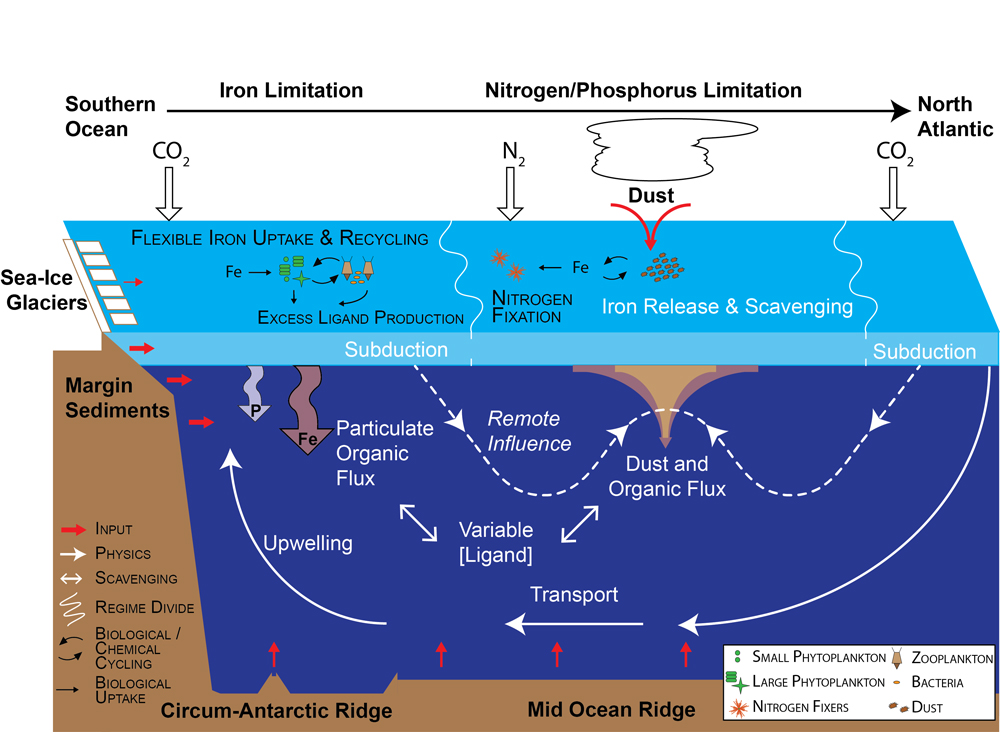Changing the paradigm on the oceanic iron cycle
Tagliabue and co-workers (2017, see reference below) discuss an extensive review on the recent findings on iron (Fe) cycle in the ocean. They figure out clearly that:
- Fe is a nutrient as essential as nitrogen (N) or phosphorus (P) for the phytoplankton. In other words, the full understanding of any marine ecosystem cannot neglect the analysis of micronutrients anymore.
- Fe oceanic sources are multiple, and supply from continental margins extends far beyond the coastal zone while striking Fe inputs from hydrothermal activity along mid-ocean ridges were observed in all the oceans. This revolutionizes the preceding view of the dust inputs, although those are essential drivers of N2 fixation at low latitude.
- The cycling of organic iron-complexing ligands has also emerged as a crucial component of the ocean iron cycle, ligand concentrations being not as uniform as considered earlier.
- It is also recognized that phytoplankton can exhibit substantial variations in their iron stoichiometry in different environments…
Synthesizing these new insights provides a more refined picture of the ocean iron cycle, challenging the global ocean modelling for testing hypotheses and projections of change. The authors also draw exciting new frontiers for the oceanic Fe cycle…
 Figure: This figure shows a revised model of the major processes in the ocean iron cycle, with focus on the Atlantic Ocean. Note that there is a broad meridional contrast between the iron-limited Southern Ocean and the major nutrient-limited low-latitude regimes. Dust remains a dominant source in the low latitudes, but continental margin and upwelled hydrothermal sources are more important in the Southern Ocean. Flexible iron uptake and biological cycling, together with the production of excess iron-binding ligands, dominate the Southern Ocean. Nitrogen fixation occurs in the low latitudes (although this process can also be restricted by lack of iron outside the North Atlantic subtropical gyre). The particulate organic iron flux is decoupled from that of phosphorus at high latitudes and the flux of lithogenic material is important at low latitudes influenced by dust. Subduction of excess organic iron-binding ligands from the Southern Ocean has a remote influence on the interior ocean at low latitudes. Click here to view the figure larger. (Modified from Tagliabue et al., 2017, Nature)
Figure: This figure shows a revised model of the major processes in the ocean iron cycle, with focus on the Atlantic Ocean. Note that there is a broad meridional contrast between the iron-limited Southern Ocean and the major nutrient-limited low-latitude regimes. Dust remains a dominant source in the low latitudes, but continental margin and upwelled hydrothermal sources are more important in the Southern Ocean. Flexible iron uptake and biological cycling, together with the production of excess iron-binding ligands, dominate the Southern Ocean. Nitrogen fixation occurs in the low latitudes (although this process can also be restricted by lack of iron outside the North Atlantic subtropical gyre). The particulate organic iron flux is decoupled from that of phosphorus at high latitudes and the flux of lithogenic material is important at low latitudes influenced by dust. Subduction of excess organic iron-binding ligands from the Southern Ocean has a remote influence on the interior ocean at low latitudes. Click here to view the figure larger. (Modified from Tagliabue et al., 2017, Nature)
Reference:
Tagliabue, A., Bowie, A. R., Boyd, P. W., Buck, K. N., Johnson, K. S., & Saito, M. A. (2017). The integral role of iron in ocean biogeochemistry. Nature, 543(7643), 51–59. DOI: http://doi.org/10.1038/nature21058
